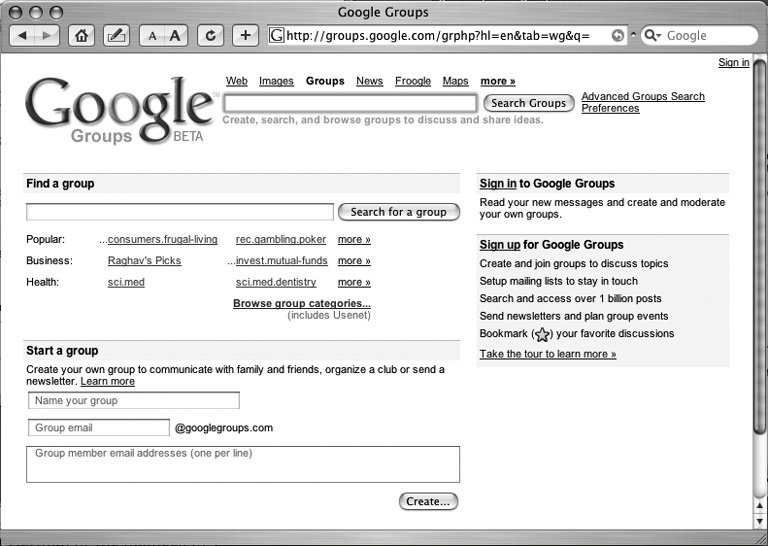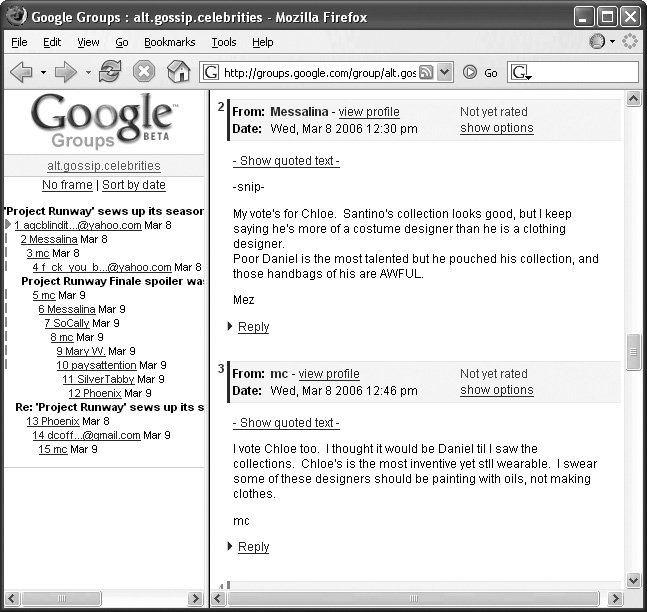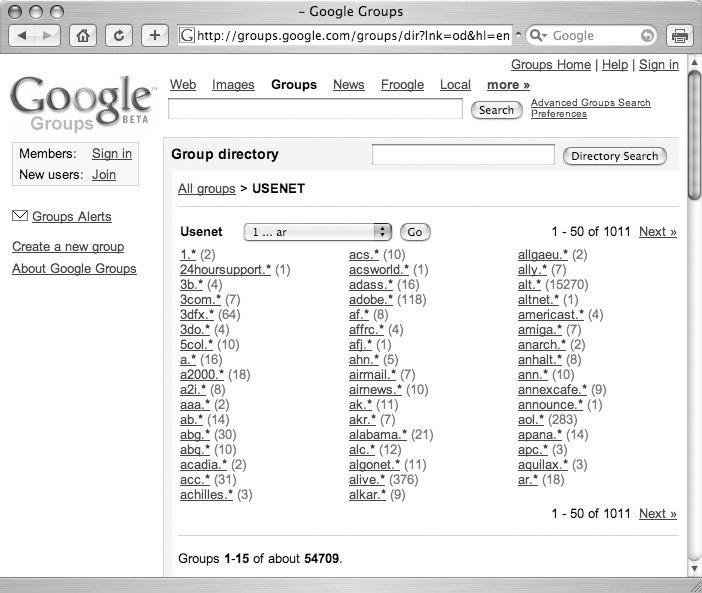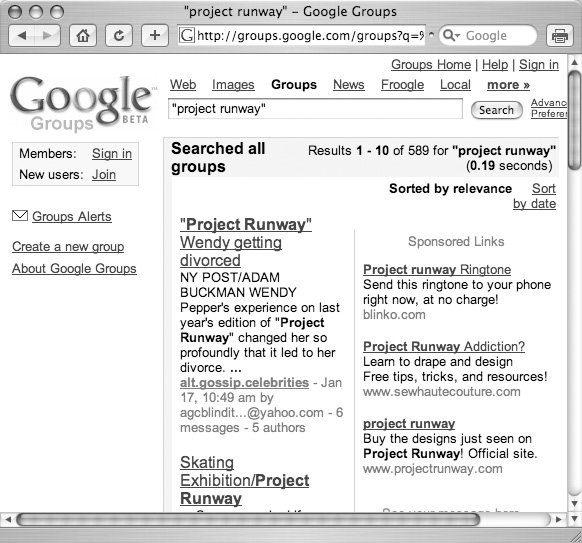Section 16.1. Finding and Searching Groups
16.1. Finding and Searching GroupsGoogle Groups is the biggest and most famous community of discussions; it tends to hog a lot of attention due to its Usenet pedigree. But it's not the only discussion game in town.
Yahoo, America Online, and MSN offer similar groups. These groups are separate communities, though; if you post about your 1971 Dodge Dart in the vintage cars group on AOL, nobody in Yahoo or MSN's car groups can see it. You may have to browse until you find a group that feels like home, but you can find or make a group on anything and everything. To give you some idea of what's out there (and what to expect once you get there), the next few pages take you on a tour of the bigger players in the discussion groups game: Google, Yahoo, MSN, and AOL. Tip: In addition to groups hosted by the big guys, there are thousands upon thousands of other discussion forums around the Web, including those hosted by gaming and music sites. While posts from many forums show up in standard search engine results, a search engine dedicated to tracking down all the ongoing conversations can help you zero in on topics you'd like to join. If you're bored with the boards you're on already or haven't found a good one yet, try searching for new conversations with specialized search sites like BoardTracker (www.boardtracker.com) or Board-Reader (www.boardreader.com ). 16.1.1. Google GroupsGoogle has hosted Usenet newsgroups under the name Google Groups since 2001. You can see it at http://groups.google.com. The Big G recently gave the whole enterprise a speed boost; new postings to the boards now appear online in about 10 seconds. (In that time, they also become available for searching when you use the Search Groups box described in Section 16.1.1.3.) Google Groups now includes thousands of very active groups, plus the Usenet archivesall of which total about a billion messages and counting. The biggest advantage of being part of the Google family is that the groups and their archives now appear as Web pages, with the power of the Google search system built right in. You can look up information by keyword, by date, even by author, and you're bound to find something juicy every time you dive in. To create, join in, and post messages in Google Groups, you need to sign up for a free Google Account. A Google Account isn't the same thing as a Gmail account (Section 14.1.4.2); but if you already have a Gmail user name and password, you can use it for Groups. There's a Sign Up link on the front page of Google Groups, shown in Figure 16-1. As you click through the screens during the account-creation process, you can pick an online nickname that will appear on your messages. If so inclined, you can also fill out a biographical profile: your geographic location, blog address (if you have one), and favorite inspirational quote. Figure 16-1. Listing every single Google Group on the main page might make your eyeballs melt, so Google gives you a "Find a group" search box right up front so you can search for topics that interest you instead of staggering through a list the size of the Shanghai phone book. The Search box at the top of the page lets you search for keywords within Group postings. Google lists some of the popular groups on the page as well, and gives you the opportunity to start your very own group at the bottom. Of course, to do that, you need a Google Account, and you can either sign up or sign in to one on the right side of the page. 16.1.1.1. Using Google GroupsThere are two ways of finding discussion groups to join on Google. This is Google, after all, so searching for groups by keyword or topic is one option. Using the "Find a group" box on the main Groups page, you can seek out topics you're interested in, like ferret care or dulcimer playing. If you prefer to just poke around, click the "Browse group categories" link. On the resulting Group Directory page, Google neatly clumps all its groups into categories arranged by:
Note: There may be some variation in the wording, but the corresponding group home pages on Yahoo Groups and the other portals break out major topics almost exactly the same way as Google. All the sites may have group discussions devoted to sailboating, so if you don't like the personality mix or info offered on Google, try one of the other group gatherings. There's also a "Browse all of Usenet" link that lets you drive by all the groups created by Google Groups members and takes you to all the old-school Usenet newsgroups (Section 16.1), many of which are still very lively. When you click a category link on the Group Directory page, all the groups that fall under it are displayed in a list, along with a brief TV Guidestyle capsule description for each ("Shortwave radio enthusiasts " or "A group for Grateful Dead-heads"). You also see how many members are in the group and how active it is. Click a group's name to go to its page. Note: Some groups require formal membership before you can participate in the discussion. Members-only groups are labeled as " restricted" in the description. To join a restricted group, click "Apply for membership" to send a message to the group's owner or moderator for approval. Some restricted groups are also listed as " invitation only"; click "Send email to owner" to compose and send your humble request. If the group belongs to Usenet or has an open membership, you see all the recent posts and topics under discussion by its members. Each topic title is a link; click to see all the responses to the original message (Figure 16-2). Figure 16-2. As you read through the posts on the right side of the screen, you can see the discussion thread on the left that shows who participated. Click a link in the thread to jump directly to that person's post. To respond to someone's comment, click Reply, and type your message in the resulting text box. Once you finish, click Preview to proofread your message or Post to add it to the ongoing discussion. If you want to take the conversational lead, click "Start a new topic," found at the top of each Google Group's home page. Note: Each Google Group's page offers a link that lets you subscribe to a group, but that's not the same as becoming a member. Instead, this link adds the group to your My Groups list: a clickable list of all the groups you've joined. The idea is to keep your favorites all in one tidy list, so you don't have to search or browse to find the groups you like to track. 16.1.1.2. Usenet groups on GoogleThe old-school Usenet groups are organized by categories, subcategories , subsubcategories, and so on, until you hit a specific topic. Each topic has many discussions (also known as threads ) associated with it, and each discussion is made up of one or more posts. Just to make sure you know you're in geekland, Usenet groups have a peculiar naming system. Top-level categories, like those listed in Figure 16-3, are called hierarchies . All newsgroups fit into a hierarchy, as indicated by the first part of a group's name ( aol , for example, for discussions related to America Online). Subsequent parts of a name consist of subcategories and then, finally, specific topics. Figure 16-3. Usenet used to take center stage in Google Groups. Even though the company has changed things up a bit on the Groups home page, you can still find all your quirky Usenet faves in their own sections. Each part is separated by a period (or dot ). For example, the sci . (science) hierarchy has a subcategory called Agriculture, which has four topics: sci.agriculture.beekeeping, sci.agriculture.fruit, sci.agriculture.poultry , and sci.agriculture.rarites . In the beekeeping topic, a recent thread was called "Swarm prevention by foundation in the brood nest," and it had 10 posts. Note: Usenet group names always have at least two partsa hierarchy and a categoryand sometimes five or more subcategories (for example, alt.collecting.beanie-babies.discussion. moderated ). The Usenet area of Google Groups lists more than 1,000 hierarchies. Some of the most active are described in the following list.
16.1.1.3. Searching Google's archivesMany groups permit full searching through their archives all the messages ever posted there. When browsing for a group, check its description to see whether it keeps a message archive for newer members to search or look through. Yahoo and Google, for example, let only members of a group search through past posts. Since Google Groups contains the complete Usenet archive dating back to 1981, this is where you'll have the most luck searching; this material has been open to the public forever. You can search in all Google Groups (type your query into the search box on the main Groups page), or within a single hierarchy or any subcategory (Section 16.1.1.2). Figure 16-4 shows a Google Groups results page that looks a lot like a regular Google listing, with your results along the left and a few ads (a.k.a. sponsored links) along the right.
Figure 16-4. A roundup of all the newsgroups discussing "Project Runway." Usenet groups are still loud and proud, but there are plenty of newer discussion groups that have sprung up since Google gave Groups a facelift in December 2004. Like many Google services, a strip of sponsored links adorns the right side of the page. Google normally shows group results listed by relevancejust like regular results. But, in many cases, sorting by date which puts the most recent post at the topgives you much more useful listings. In fact, sorting by date is often the way to go. For example, if you're searching for a person or event that's been in the news lately, sorting by date (click the link in the upper-right corner) gives you the freshest messages. When you've found a snippet that intrigues you, and you want to read the whole message, click the title. You jump to the message in question, where your search terms are highlighted. The Google Groups Advanced Search page (Section 3.1.3) gives you a form that lets you specify what you're looking for with even more detail: messages posted within certain date ranges, by author or subject, or even containing exact phrases. It sure beats staggering through the millions of posts looking for that one nugget of information you seek, like how to install Linux on an iPod. 16.1.2. Yahoo GroupsYahoo Groups has a few million discussions of its own going on at http://groups.yahoo.com, where members post up a storm of messages and pictures. Its main Groups page lists 16 general category links, like Music or Government & Politics, so that you can browse your way down through the listings. You burrow down from categories to actual messages just as you do on Google Groups: by clicking your way from Hobbies & Crafts to Potato Guns, Juggling, and Pottery, to subcategories, to actual groups. You can search for groups by topic or keyword in the same way, too. One cool thing about Yahoo's group effort is that, unlike Google, members are allowed to post photos along with text, which can really liven things up visually. You can browse around without having to sign into the Yahoo mother ship. But if you want to post anywhere , the site asks you to sign in with your Yahoo ID. If you already have one for Yahoo Mail, Messenger, or whatever you may have signed up for before, you can use the same name and password here. If you don't have a Yahoo ID, you have the option to make one this very minutefree of charge, of courseon the Sign-in page. Also, as with Google, you can create a little biographical profile for yourself; to preserve your privacy, it's best to leave out stuff like your address and phone number.
Yahoo's groups can be either Public or Membership Required. In Public groups, you see posts right away when you click the group's name, and you can post messages without formally joining (although you do have to sign into Yahoo). Members-only groups require that you click the Join This Group link and fill out a form to get in and see postings by other members. One good thing about members-only groups is that the approval process prevents the random advertising invasion that has turned parts of Usenet into a vast wasteland of spam. On a group's Yahoo home page, you'll find something called the Message History graphic, which shows how many posts people have generated since the group was formed . If you're a member, click a month to read all the posts generated during that time. Click the Members link on the left side of a group's page to see a list of everyone who belongs to the group along with their Yahoo profiles, if any. Tip: You can participate in Yahoo discussions entirely by email, if you find that convenient. When you join the group, there's a place on the membership form for an email address of your choice. Furthermore, each group page lists all the email addresses you need to send posts to the group, subscribe, unsubscribe, and so on. The panel on the left side of a Yahoo group's page gives you plenty of other things to share besides text messages. For instance, you can add pictures to the group's Web page by clicking the Photos link. You can share files like Word documents or PDF files, too, if you think they'd be helpful to the participants of a discussion (click the Files link). Click the Calendars link to create an online calendar for scheduling group activities. Like Google Groups, ads and sponsored links surround each Groups page (though not the actual message area). These commercial links usually offer products and services related to the discussion topic on the page. They're a small price to pay for keeping in touch with your friends . 16.1.3. MSN GroupsMSN Groups are Microsoft's version of Web-based discussion boards. Each MSN group can be open to the public or entirely private and require an invitation to join. Your first stop on the way to joining one of MSN's Groups is http://groups.msn.com. To get into a group, you need a Microsoft ID, known as a .NET Passport, or a Hotmail address (Section 14.1.4.3). There are thousands of groups available, all with their own Web sites; you can see the list by clicking Browse Groups on the main page. Once again, you can click down through categories or perform a search for a discussion topic. MSN includes a graphic next to each group's description: an Activity Meter icon that resembles a speedometer to give you an indication of how busy this particular group is. If the needle's all the way to the right, this is a chatty group indeed. Many groups let you snoop around without formally joining. Unless you sign up to be a member, though, you can't participate in the group discussion or interact with other members. Some groups, especially those that are women-only or men-only, don't even permit browsing by non-members. When you have some memberships under your belt, you can check for new messages by clicking the My Groups tab on the main Groups page. Here again, you can read messages posted on the board's Web site or have them delivered to your email inbox. 16.1.4. Groups@AOLOnce the electronic equivalent of a gated community open only to paying subscribers, America Online has been opening up parts of its service to the general Web population for the past few years . For example, its online discussion circles are now available to the public at http://groups.aol.com. Anyone with an AIM name (Section 15.2.1) or AOL membership can join a group, although only paying AOL members can create new groups. Compared to some of the other services, AOL's Groups aren't as active or organized, and many groups listed on directory pages are obviously posts from spammers. AOL Groups can be public or private and are run by group members. In contrast, AOL's discussion boards (http://peopleconnection.aol.com/messageboards) are all public and similar in size and scope to the old-school Usenet-style bulletin boards. Topics are set by AOL and some boards are moderated by AOL staffers to remove offensive posts and keep the peace . You can search and read posts without signing up, but you'll need an AOL account or at least a free AIM screen name to post replies. The best thing about the AOL discussion boards? You can choose to ignore messages by people you find obnoxious by clicking the "Ignore" link at the bottom of the offending party's post. |
EAN: 2147483647
Pages: 147
- ERP System Acquisition: A Process Model and Results From an Austrian Survey
- The Second Wave ERP Market: An Australian Viewpoint
- Enterprise Application Integration: New Solutions for a Solved Problem or a Challenging Research Field?
- Context Management of ERP Processes in Virtual Communities
- Intrinsic and Contextual Data Quality: The Effect of Media and Personal Involvement